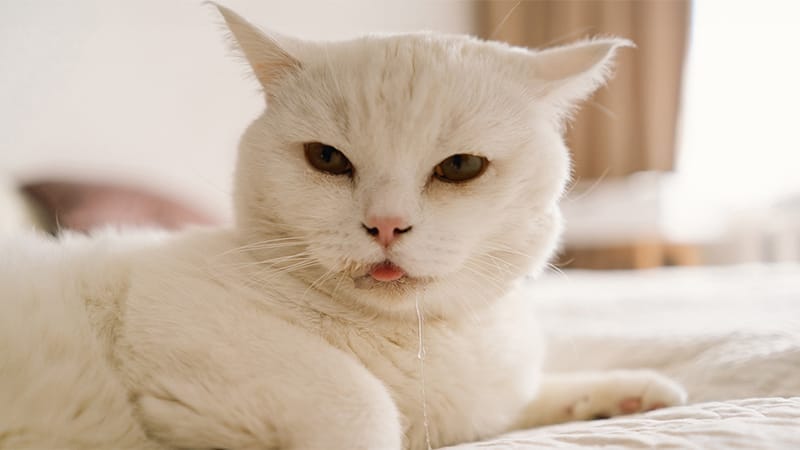
Within the spring, significantly through the Easter season, it is not uncommon to carry stunning lilies into houses. Nevertheless, if you might have cats as a part of your loved ones, it can be crucial to know that these crops are poisonous to them. To hold your pet protected from lilies, learn on as we focus on the indicators of lily poisoning, what steps to take for those who suspect your cat has been uncovered to lilies, obtainable therapy choices, the prognosis for affected cats, and important ideas to make sure your cat’s security at house.
Understanding Lily Poisoning in Cats
Even a small quantity of ingestion, equivalent to chewing on a leaf or consuming water from a vase containing lilies, can result in extreme lily poisoning and induce acute kidney failure in as little as 12 to 24 hours. In case your cat doesn’t obtain any therapy, their kidneys will fail, resulting in dying 24 to 72 hours after ingestion.
Whereas there are numerous species of lilies, there are two which are significantly poisonous to cats, together with true lilies (Lilium species) and daylilies (Hemerocallis species). True lilies embrace Easter lily, Tiger lily, Oriental lily, Japanese present lily, Rubrum lily, Asiatic lily, Stargazer lily, and Wooden lily.
Though calla lily and peace lily have “lily” of their identify, they usually are not true lilies and don’t trigger kidney failure in cats. Nevertheless, they do comprise oxalate crystals that could cause milder indicators, equivalent to irritation within the mouth, throat, tongue, and esophagus. The least poisonous of all lily crops is the Peruvian lily, which could cause gentle upset abdomen.

Indicators of Lily Poisoning in Cats
Early recognition and intervention for lily poisoning in cats can drastically enhance the possibilities of a optimistic final result.
The next are widespread indicators to look at for:
- Vomiting: Cats could expertise vomiting inside a couple of hours of ingesting any a part of a lily plant.
- Lack of urge for food: A sudden lower in urge for food or refusal to eat might be a sign of lily poisoning in cats.
- Lethargy: Cats could develop into unusually drained or weak, exhibiting an absence of power and curiosity of their environment.
- Elevated thirst and urination: Lily poisoning can result in elevated water consumption and frequent urination.
- Drooling: Extreme drooling or hypersalivation could happen resulting from the irritant results of the lily toxins.
- Dehydration: Cats could exhibit indicators of dehydration, equivalent to dry gums, sunken eyes, and decreased pores and skin elasticity.
- Kidney failure: That is probably the most extreme consequence of lily poisoning in cats and may manifest as decreased urine manufacturing, elevated thirst, and finally, a decline in total well being.

What to Do if You Suspect Lily Poisoning
If you happen to suspect that your cat has been uncovered to lilies or is exhibiting any indicators of lily poisoning, contact your veterinarian instantly. They might recommend calling the Pet Poison Helpline at 855-764-7661. In case your veterinarian just isn’t obtainable, contact the closest emergency veterinarian, equivalent to MedVet. It is useful for those who know which number of lilies your cat was uncovered to and the quantity if consumed. Don’t induce vomiting except directed by your veterinarian. Fast therapy is important for cats with lily poisoning to enhance their probability of survival.
What to Count on from Lily Poisoning Therapy
The therapy for lily poisoning in cats focuses on stopping additional absorption of poisons and supporting the cat’s kidneys.
Reckoning on the severity of the poisoning, your veterinarian could advocate the next:
- Inducing vomiting: If the ingestion occurred throughout the previous two hours and your cat just isn’t exhibiting any indicators, your veterinarian could induce vomiting to take away the toxins from the abdomen.
- Activated charcoal: Activated charcoal could also be given to your cat to bind the toxins and assist it transfer via the gastrointestinal tract.
- Testing: Baseline lab work, together with an entire blood depend (CBC), serum chemistry profile, and urinalysis are all necessary to guage your cat’s organ standing, particularly the kidneys. An belly ultrasound might also be advisable to see if there’s any kidney injury.
- Intravenous fluids: Cats with lily toxicity typically require intravenous fluids to keep up hydration and assist kidney operate. Fluids are given for no less than 48-72 hours whereas monitoring your cat’s urine output, which can require them to have a urinary catheter.
- Kidney assist: Medicines and remedies could also be administered to assist kidney operate and decrease injury.

Prognosis for Cats with Lily Toxicity
The prognosis for cats affected by lily toxicity varies based mostly on components equivalent to the quantity ingested, timing of intervention, and the cat’s total well being. Cats that obtain immediate veterinary care have a greater probability of restoration. Nevertheless, if therapy is delayed 18 hours or extra after ingestion or your cat ingested a major quantity of lilies, your cat will seemingly have irreversible kidney failure. In case your cat stops urinating about 24 hours after ingestion, it’s unlikely they’ll survive.
Cats who survive lily poisoning might want to have common checkups and bloodwork as soon as they’re launched to make sure their kidneys proceed to recuperate.

